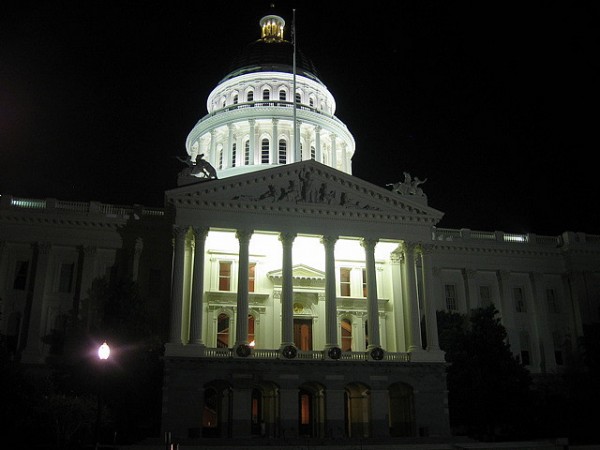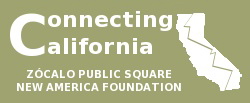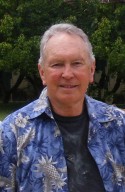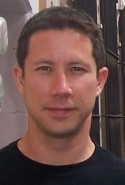
Throughout its 161-year history, California has seen attempts by its citizens to split the state. One history counts more than 200 attempts and some 27 “serious” proposals to do so. Today, the difficulties of governing a state so sprawling and populous have renewed the conversation, bringing forward proposals from inland elected officials to break the state up. And people are listening. In advance of “Is California Too Big?”, a Zócalo event in Fresno, we asked several knowledgeable Californians if they thought there was any merit to such ideas. Should California be spit in two?
No, guys, just learn to compromise.
The latest version of California’s longest-running comedy routine, Split the State, is a Republican attempt to create an independent region called South California, leaving the remainder of the state with its original name and two-thirds of its present population. Much of so-called South California would actually be made up of Central California–Fresno, Kings, Tulare, Kern, Mono, and Inyo Counties, but not include distinctly southern but too liberal Los Angeles. (Such geographical ignorance tells you how seriously to take the proposal.)
All but two of the aforementioned counties are part of the Great Central Valley, a unique realm as large as Egypt, with virtually no innate connection to the so-called Inland Empire, let alone to the Los Angeles Basin or the greater Bay Area.
The new proposal falls into the old trap of thinking that somehow a north-south division makes sense. Why not divide the state into coastal, inland, mountain and desert dominions? Why not wet and dry? How about urban, suburban and rural? And on and on.
A tortured argument might be made for a tripartite division along parallel lines: North (above the Central Valley, with Sacramento River water as its bargaining chip), Center (the Great Valley plus whatever’s east and west of it, with San Joaquin River water), and South (below the Tehachapi Mountains, with some water from the Colorado River).

As for San Francisco, Los Angeles, and Sacramento, why not declare them free cities, as Danzig once was? Let them negotiate with water marshals in the Sierra or farmers in Fresno or fishermen in Eureka.
But all those variants would defeat the purpose of South California, which is to defy the American system by eliminating political competition via a kind of neo-gerrymandering, a profoundly un-American idea.
This native son likes this complicated, contentious, semi-governable state just as it is. It’s by far the most interesting state in the nation. California’s politicians should get to work on compromising and innovating and quit trying to find shortcuts.
Gerry Haslam is a Central California-based writer. He is author of In Thought and Acton: The Enigmatic Life of S. I. Hayakawa.
————————————-
Sure–and why stop at two? Not that it’ll solve anything.
About 60 percent of the countries that make up the United Nations are smaller than Los Angeles County, yet many of these nations would prefer to split themselves into even smaller entities. There is a sense that smaller is better, and this notion is heightened by deep-seated tribal allegiances that are still paramount in much of the world.
In the U.S., political differences, not tribal allegiances, are creating the pressure for separation. Conservatives don’t want to pay more taxes, and liberals would like more government regulation. So maybe it would be better if conservatives were in one state and liberals were in another. But people change their minds, and factors like immigration are changing the spaces in which we live. We might create new spaces and then find that they don’t solve our problem.
So what about California? The Inland Empire, the Central Valley, Berkeley and the Bay, and the Far North are all viable self-contained entities. Then there is the loosely connected five-county metro area of Southern California. So, if we’re going to start dividing, we should be divided into at least five parts.
And that’s fine, as long as no one thinks that dividing up California will solve any of the major issues facing the state (taxes, redistricting, legislative gridlock, and so on). That said, it would at least help remedy one thing: a lack of equality in the U.S. Senate, where a Wyoming resident has 70 times the power of a Californian. Dividing California by five would lower that ratio to merely 14 times the power of a Californian.
William A.V. Clark is distinguished professor of geography at UCLA.
————————————-
For the last time–no! We’re better than that.
Let’s try this for the 221st time: dividing California into two or more states. The latest high-profile proposal to split the state, an idea put forward by Supervisor Jeff Stone in Riverside, would create a red California and a blue California. According to Stone, “California is too big to govern, which has led the state to raid local government coffers because of runaway spending.” Splitting the State will “stop the destruction of California.”
We are told that California is too diverse to be governable. But runaway spending is not automatically stopped just by dividing the state in two. If we are re-aligning ourselves to become homogenous populations–then we have other options. For instance, Southern California can merge with Arizona to become, as someone once suggested, the State of Calzone.
California is the sixth-largest economy in the world–giving us clout in the global market today. How would having two states competing against each other help on that front?
Creating multiple states would create more representatives, which would create bigger government. How would that produce more cohesive government?
This entire notion of dividing the state to solve our problems is a cop-out.
As Californians, we should pride ourselves on our diversity and our size. We need to get beyond labels, the red-blue divide, and sound bites.
We all share certain values and aspirations for ourselves and our communities. We need to create comfortable and safe spaces for people to have civil conversations and opportunities to understand different perspectives. And each of us must have a chance to practice democracy in its true spirit so that we can collectively begin to address issues. That’s what the Reviving California initiative of the American Leadership Forum is committed to doing.
Anu Natarajan is Reviving California Program Director at the American Leadership Forum-Silicon Valley and is Vice Mayor for the City of Fremont.
————————————-
No–it wouldn’t fix a thing
Shouldn’t happen. Can’t happen. Won’t happen. Since the Gold Rush, Californians have imagined alternative cartographies for their state. Over the years, these schemes have varied in their proposed boundaries, but the rationale remains the same: that reconfiguring or subdividing the state will finally exorcise the crises that keep haunting us. We’ll finally realize our potential.
In reality, while the size of California’s population, the reach of its economic production, and the scope of its political crises may stand out, they are hardly exceptional. Other large states–Texas, Illinois, New York, and Florida–are riven by similarly complicated patterns of growth, governance, and geographic difference.
The quantity of California’s problems may be different, but the quality is not. California, like many large states, has become marked by wide-ranging inequalities in wealth, income and access to opportunity. Its economy is deeply dependent on low-wage labor, yet its social and political infrastructure facilitates the upward, rather than downward, redistribution of resources. Trenchant racial hierarchies remain, evidenced most dramatically in the state’s expansive system of prisons and its emaciated system of public education.
No act of geographic metamorphosis will insulate the state from these problems.
Daniel Martinez HoSang is the author of Racial Propositions: Ballot Initiatives and the Making of Postwar California.
*Photo courtesy of queenkv.







